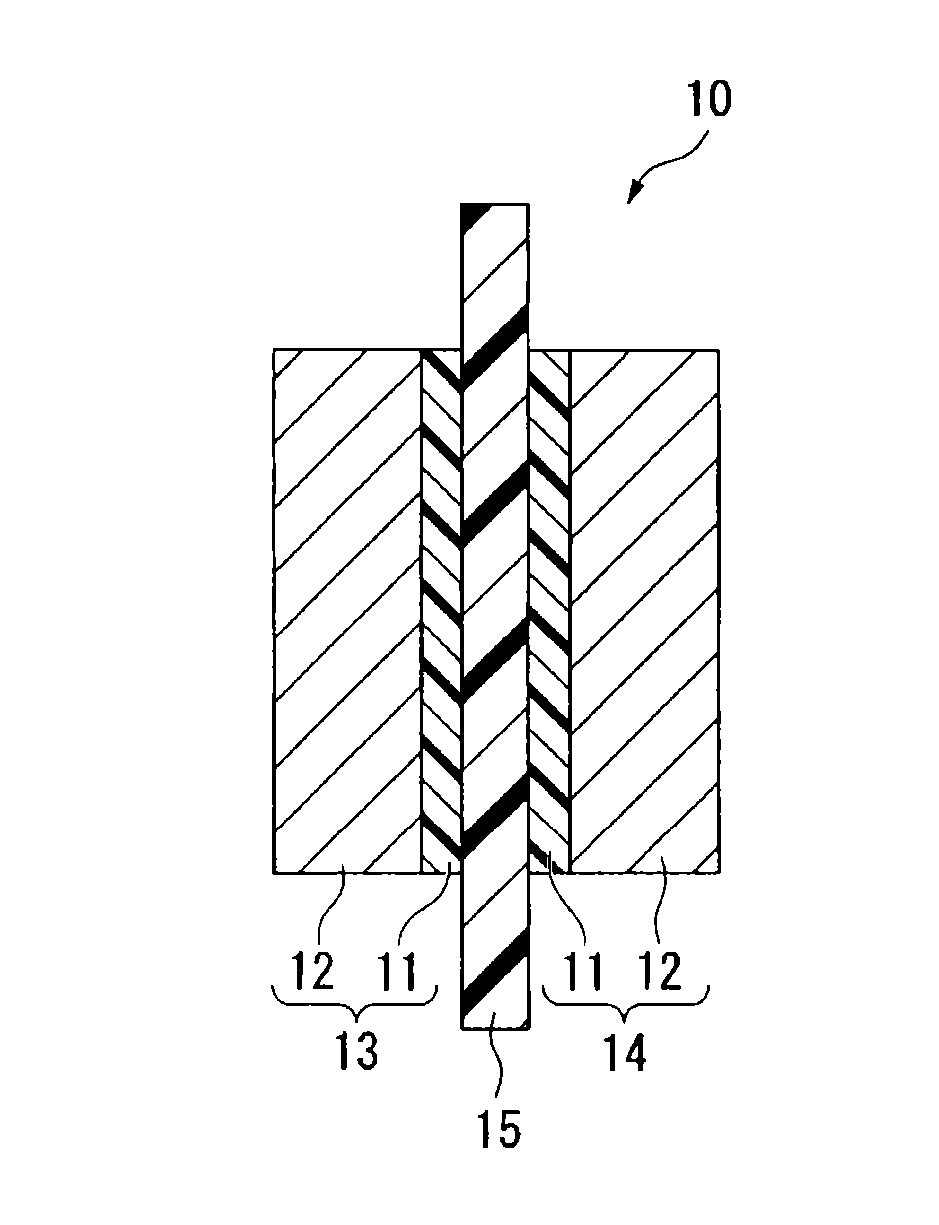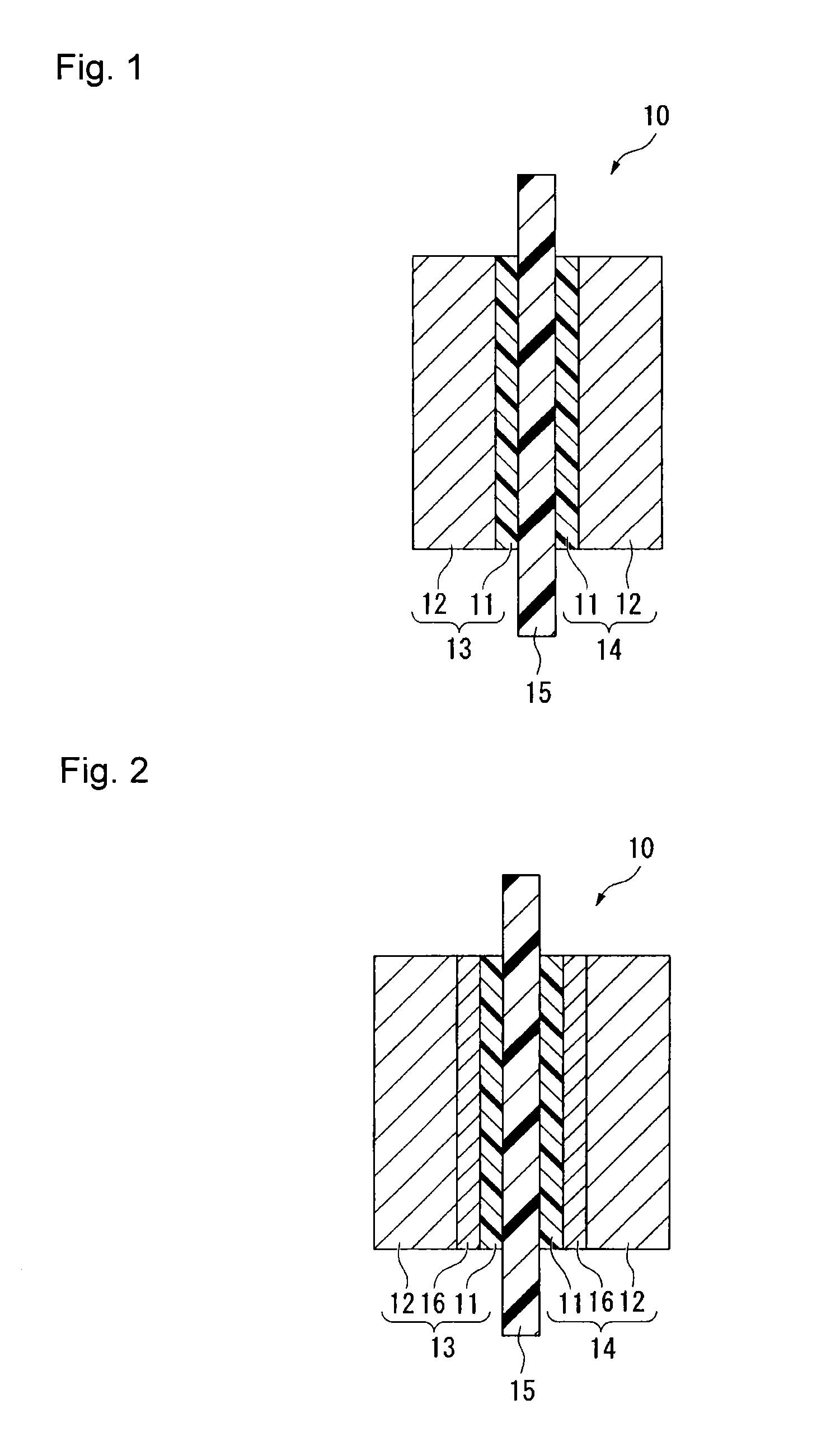Process for producing fluorinated ion exchange resin fluid
a technology of ion exchange resin and process, which is applied in the manufacture of final products, cell components, electrochemical generators, etc., can solve the problems of gas leakage, incomplete adhesion to the catalyst layer, and deterioration of the polymer electrolyte membrane or the catalyst layer, etc., to achieve good durability, good durability, and less wrinkles
- Summary
- Abstract
- Description
- Claims
- Application Information
AI Technical Summary
Benefits of technology
Problems solved by technology
Method used
Image
Examples
example 1
Preparation of Fluorinated Ion Exchange Resin Fluid
Step (β1):
[0319]Polymer (F1-1) (copolymer of TFE and monomer (m1-1), ion exchange capacity after hydrolysis: 1.1 meq / g dry resin) was put into an extruder and extruded from a die having a hole of 4 mm in diameter and heated to 200° C. and pulled at a rate slightly higher than the extrusion rate and cooled, followed by cutting by a pelletizer to obtain pellets of polymer (F1-1) having a cross-sectional diameter of from 1 to 3 mm and a length of from 5 to 20 mm.
Step (β2):
[0320]450 g of the pellets of polymer (F1-1) were put into a reactor made of glass and having an internal capacity of 2.5 L, and 0.68 kg of an aqueous potassium hydroxide solution having a concentration of 48 mass %, 0.44 kg of methanol and 1.0 kg of ultrapure water were put, and the temperature was raised with stirring until the internal temperature became 90° C., and while controlling the temperature to be ±3° C., the system was maintained for 16 hours. Thereafter, ...
example 2
Production of Fluorinated Ion Exchange Resin Fluid
Step (α1):
[0336]Pellets of polymer (F1-1) having a cross-sectional diameter of from 1 to 3 mm and a length of from 5 to 20 mm, obtained in step (β1) in Example 1, were prepared.
Step (α2):
[0337]Pellets of salt-form polymer (H1-1) were obtained by carrying out hydrolytic treatment in the same manner as step (β2) in Example 1.
Step (α3):
[0338]Into the reactor, 2.0 kg of ultrapure water was put, the temperature was raised to 85° C., and stirring was carried out for one hour, and then, the temperature was lowered, and water was discharged. Such an operation was repeated ten times in total. The pH of the water discharged the 10th time was confirmed to be 8.
Step (α4):
[0339]Pellets of hydrogen peroxide-treated salt-form polymer (H1-1) were obtained by carrying out hydrogen peroxide treatment in the same manner as step (β6) in Example 1.
Step (α5):
[0340]Washing with water was carried out in the same manner as step (β7) in Example 1.
Step (α6):
[0...
example 3
Production of Fluorinated Ion Exchange Resin Fluid
Step (α1):
[0349]Pellets of polymer (F1-1) having a cross-sectional diameter of from 1 to 3 mm and a length of from 5 to 20 mm, obtained in step (β1) in Example 1, were prepared.
[0350]The pellets of polymer (F1-1) were put into a pulverizer (manufactured by HORAI Co, Ltd.) and pulverized to a level of from 0.5 to 2 mm to obtain a powder of polymer (F1-1).
Steps (α2) to (α8):
[0351]A fluorinated ion exchange resin fluid (L-3) having a solid content concentration of 28 mass %, was obtained in the same manner as steps (α2) to (α8) in Example 2 except that instead of the pellets of polymer (F1-1), the powder of polymer (F1-1) was used.
(Formation of Polymer Electrolyte Membrane)
[0352]A polymer electrolyte membrane (M-3) was obtained in the same manner as in Example 1 except that instead of the fluorinated ion exchange resin fluid (L-1), the fluorinated ion exchange resin fluid (L-3) was used. No wrinkles were observed on the polymer electrol...
PUM
 Login to View More
Login to View More Abstract
Description
Claims
Application Information
 Login to View More
Login to View More - R&D
- Intellectual Property
- Life Sciences
- Materials
- Tech Scout
- Unparalleled Data Quality
- Higher Quality Content
- 60% Fewer Hallucinations
Browse by: Latest US Patents, China's latest patents, Technical Efficacy Thesaurus, Application Domain, Technology Topic, Popular Technical Reports.
© 2025 PatSnap. All rights reserved.Legal|Privacy policy|Modern Slavery Act Transparency Statement|Sitemap|About US| Contact US: help@patsnap.com



